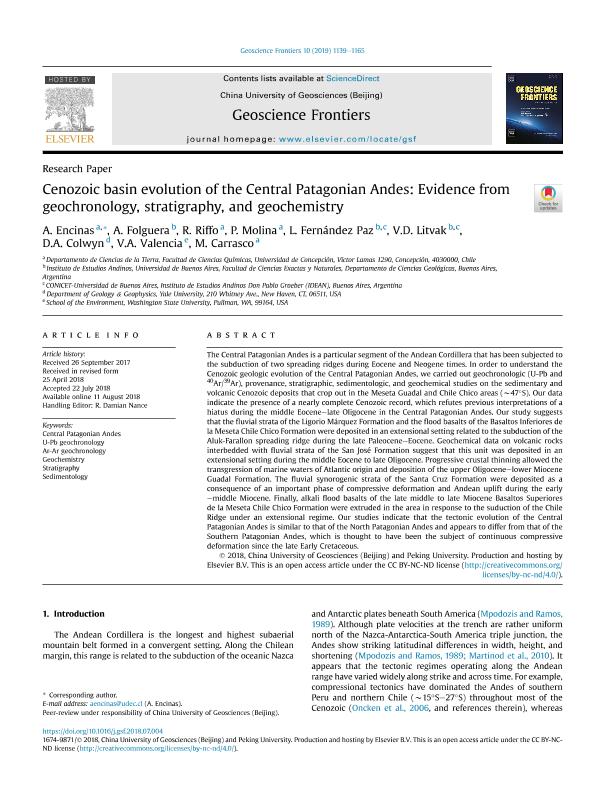Mostrar el registro sencillo del ítem
dc.contributor.author
Encinas, A.
dc.contributor.author
Folguera Telichevsky, Andres

dc.contributor.author
Riffo, R.
dc.contributor.author
Molina, P.
dc.contributor.author
Fernández Paz, Lucía

dc.contributor.author
Litvak, Vanesa Dafne

dc.contributor.author
Colwyn, D. A.
dc.contributor.author
Valencia, V. A.
dc.contributor.author
Carrasco, M.
dc.date.available
2020-02-13T19:59:15Z
dc.date.issued
2019-05
dc.identifier.citation
Encinas, A.; Folguera Telichevsky, Andres; Riffo, R.; Molina, P.; Fernández Paz, Lucía; et al.; Cenozoic basin evolution of the Central Patagonian Andes: Evidence from geochronology, stratigraphy, and geochemistry; Elsevier; Geoscience Frontiers; 10; 3; 5-2019; 1139-1165
dc.identifier.issn
1674-9871
dc.identifier.uri
http://hdl.handle.net/11336/97468
dc.description.abstract
The Central Patagonian Andes is a particular segment of the Andean Cordillera that has been subjected to the subduction of two spreading ridges during Eocene and Neogene times. In order to understand the Cenozoic geologic evolution of the Central Patagonian Andes, we carried out geochronologic (U-Pb and 40Ar/39Ar), provenance, stratigraphic, sedimentologic, and geochemical studies on the sedimentary and volcanic Cenozoic deposits that crop out in the Meseta Guadal and Chile Chico areas (∼47°S). Our data indicate the presence of a nearly complete Cenozoic record, which refutes previous interpretations of a hiatus during the middle Eocene–late Oligocene in the Central Patagonian Andes. Our study suggests that the fluvial strata of the Ligorio Márquez Formation and the flood basalts of the Basaltos Inferiores de la Meseta Chile Chico Formation were deposited in an extensional setting related to the subduction of the Aluk-Farallon spreading ridge during the late Paleocene–Eocene. Geochemical data on volcanic rocks interbedded with fluvial strata of the San José Formation suggest that this unit was deposited in an extensional setting during the middle Eocene to late Oligocene. Progressive crustal thinning allowed the transgression of marine waters of Atlantic origin and deposition of the upper Oligocene–lower Miocene Guadal Formation. The fluvial synorogenic strata of the Santa Cruz Formation were deposited as a consequence of an important phase of compressive deformation and Andean uplift during the early–middle Miocene. Finally, alkali flood basalts of the late middle to late Miocene Basaltos Superiores de la Meseta Chile Chico Formation were extruded in the area in response to the suduction of the Chile Ridge under an extensional regime. Our studies indicate that the tectonic evolution of the Central Patagonian Andes is similar to that of the North Patagonian Andes and appears to differ from that of the Southern Patagonian Andes, which is thought to have been the subject of continuous compressive deformation since the late Early Cretaceous.
dc.format
application/pdf
dc.language.iso
eng
dc.publisher
Elsevier

dc.rights
info:eu-repo/semantics/openAccess
dc.rights.uri
https://creativecommons.org/licenses/by-nc-sa/2.5/ar/
dc.subject
AR-AR GEOCHRONOLOGY
dc.subject
CENTRAL PATAGONIAN ANDES
dc.subject
GEOCHEMISTRY
dc.subject
SEDIMENTOLOGY
dc.subject
STRATIGRAPHY
dc.subject
U-PB GEOCHRONOLOGY
dc.subject.classification
Geociencias multidisciplinaria

dc.subject.classification
Ciencias de la Tierra y relacionadas con el Medio Ambiente

dc.subject.classification
CIENCIAS NATURALES Y EXACTAS

dc.title
Cenozoic basin evolution of the Central Patagonian Andes: Evidence from geochronology, stratigraphy, and geochemistry
dc.type
info:eu-repo/semantics/article
dc.type
info:ar-repo/semantics/artículo
dc.type
info:eu-repo/semantics/publishedVersion
dc.date.updated
2020-01-06T17:04:25Z
dc.journal.volume
10
dc.journal.number
3
dc.journal.pagination
1139-1165
dc.journal.pais
China

dc.description.fil
Fil: Encinas, A.. Universidad de Concepción; Chile
dc.description.fil
Fil: Folguera Telichevsky, Andres. Consejo Nacional de Investigaciones Científicas y Técnicas. Oficina de Coordinación Administrativa Ciudad Universitaria. Instituto de Estudios Andinos "Don Pablo Groeber". Universidad de Buenos Aires. Facultad de Ciencias Exactas y Naturales. Instituto de Estudios Andinos "Don Pablo Groeber"; Argentina
dc.description.fil
Fil: Riffo, R.. Universidad de Concepción; Chile
dc.description.fil
Fil: Molina, P.. Universidad de Concepción; Chile
dc.description.fil
Fil: Fernández Paz, Lucía. Consejo Nacional de Investigaciones Científicas y Técnicas. Oficina de Coordinación Administrativa Ciudad Universitaria. Instituto de Estudios Andinos "Don Pablo Groeber". Universidad de Buenos Aires. Facultad de Ciencias Exactas y Naturales. Instituto de Estudios Andinos "Don Pablo Groeber"; Argentina
dc.description.fil
Fil: Litvak, Vanesa Dafne. Consejo Nacional de Investigaciones Científicas y Técnicas. Oficina de Coordinación Administrativa Ciudad Universitaria. Instituto de Estudios Andinos "Don Pablo Groeber". Universidad de Buenos Aires. Facultad de Ciencias Exactas y Naturales. Instituto de Estudios Andinos "Don Pablo Groeber"; Argentina
dc.description.fil
Fil: Colwyn, D. A.. University of Yale; Estados Unidos
dc.description.fil
Fil: Valencia, V. A.. Washington State University; Estados Unidos
dc.description.fil
Fil: Carrasco, M.. Universidad de Concepción; Chile
dc.journal.title
Geoscience Frontiers
dc.relation.alternativeid
info:eu-repo/semantics/altIdentifier/url/https://www.sciencedirect.com/science/article/pii/S1674987118301580
dc.relation.alternativeid
info:eu-repo/semantics/altIdentifier/doi/http://dx.doi.org/10.1016/j.gsf.2018.07.004
Archivos asociados
